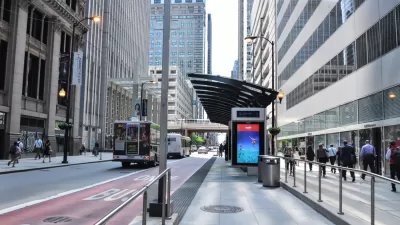Without full-time bus-only lanes, signal priority, advanced ticket sales, or all-door boarding, the Chicago Transit Authority's (CTA) tentative first steps aboard Bus Rapid Transit (BRT) may not be so speedy after all.
Jon Hilkevitch describes what will be provided when the CTA's upcoming $11 million federally funded BRT experiment launches later this year on the No. 14 route, and it seems to fall short of the standard characterization of Bus Rapid Transit.
Being careful not to offend car drivers by "imposing major negative impacts," the main features of the "BRT" that will operate on Jeffery Boulevard will be limited stops, traffic signal priority for a 1.5-mile stretch (which won't be operational until 2013), and part-time bus-only lanes, reports Hilkevitch.
New shelters, newly branded buses, and monitors inside buses displaying bus and train tracking information should help make the route feel special, even if, as Hilkevitch asserts, "the modest experiment is a far cry from CTA plans unveiled only two years ago to help address the city's congestion crisis."
"Transit officials plan to follow up with more robust BRT efforts in the central Loop in 2014 and in subsequent years on Western and Ashland avenues when money becomes available."
Yet some fear, "that the CTA's watered-down, phased-in substitute could form the public misconception that BRT isn't much of an improvement over regular express bus service, except for the fancy packaging and higher cost."
FULL STORY: CTA's bus rapid transit won't be so rapid

Alabama: Trump Terminates Settlements for Black Communities Harmed By Raw Sewage
Trump deemed the landmark civil rights agreement “illegal DEI and environmental justice policy.”

Planetizen Federal Action Tracker
A weekly monitor of how Trump’s orders and actions are impacting planners and planning in America.

The 120 Year Old Tiny Home Villages That Sheltered San Francisco’s Earthquake Refugees
More than a century ago, San Francisco mobilized to house thousands of residents displaced by the 1906 earthquake. Could their strategy offer a model for the present?

In Both Crashes and Crime, Public Transportation is Far Safer than Driving
Contrary to popular assumptions, public transportation has far lower crash and crime rates than automobile travel. For safer communities, improve and encourage transit travel.

Report: Zoning Reforms Should Complement Nashville’s Ambitious Transit Plan
Without reform, restrictive zoning codes will limit the impact of the city’s planned transit expansion and could exclude some of the residents who depend on transit the most.

Judge Orders Release of Frozen IRA, IIJA Funding
The decision is a victory for environmental groups who charged that freezing funds for critical infrastructure and disaster response programs caused “real and irreparable harm” to communities.
Urban Design for Planners 1: Software Tools
This six-course series explores essential urban design concepts using open source software and equips planners with the tools they need to participate fully in the urban design process.
Planning for Universal Design
Learn the tools for implementing Universal Design in planning regulations.
Clanton & Associates, Inc.
Jessamine County Fiscal Court
Institute for Housing and Urban Development Studies (IHS)
City of Grandview
Harvard GSD Executive Education
Toledo-Lucas County Plan Commissions
Salt Lake City
NYU Wagner Graduate School of Public Service





























